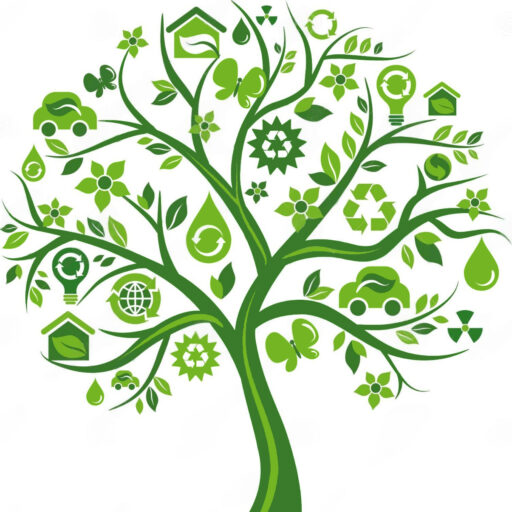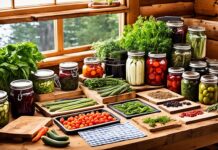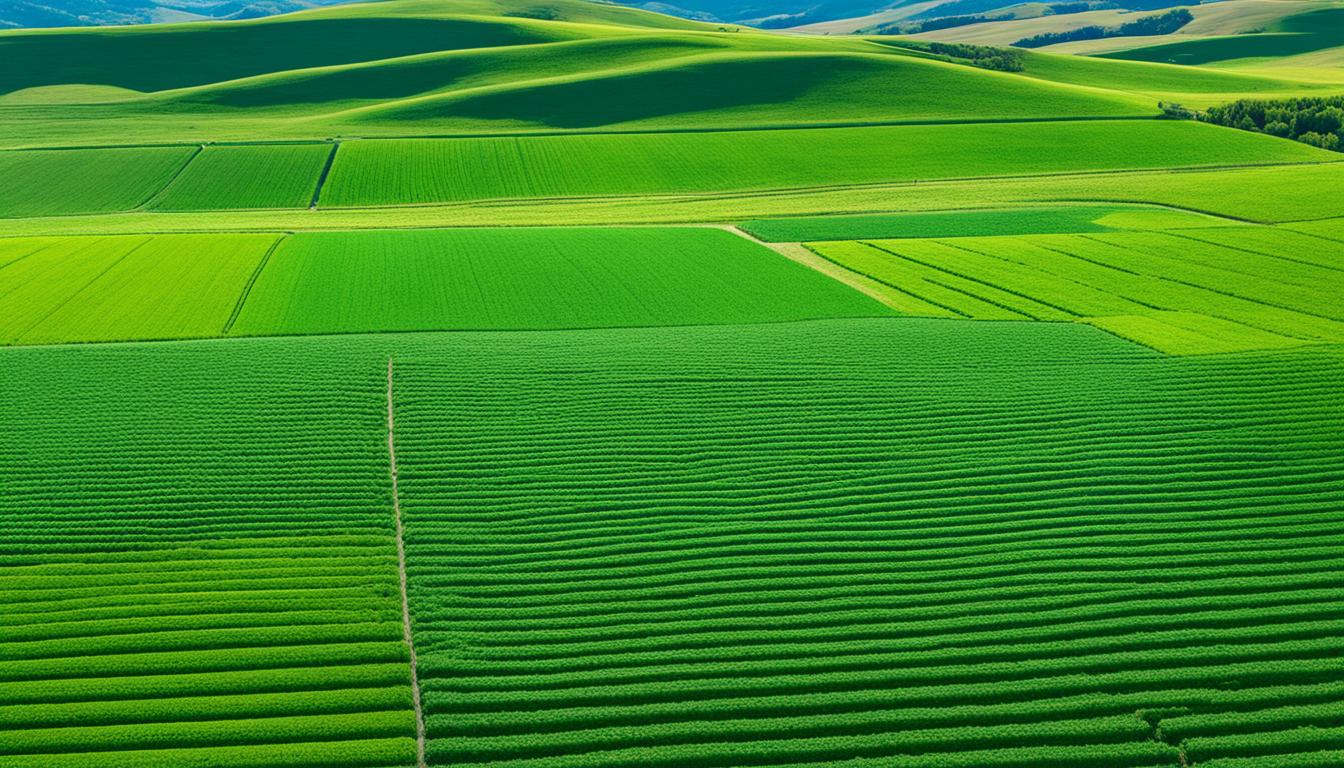Sustainable agriculture is all about making food production better for the planet, people, and the economy. It’s a way to grow food that’s good for everyone. By using sustainable methods, farmers can help the environment and make more money. They also improve life for those living close to their farms1.
As the world’s population grows, reaching 9 billion by 2050, we need sustainable farming more than ever1. Sustainable farming includes many methods like organic and regenerative farming. These methods help save resources like water and soil and reduce chemical use1.
By using new technologies like IoT sensors and AI, farmers can work smarter and more efficiently. This leads to better farming and a healthier planet1.
Key Takeaways
- Sustainable agriculture practices aim to meet the growing food demands while protecting the environment and natural resources.
- Sustainable farming techniques, such as organic and regenerative methods, can increase profitability and enhance the quality of life for rural communities.
- Leveraging advanced technologies, including IoT, data analytics, and AI, can contribute to more efficient and sustainable farming operations.
- Sustainable agriculture practices prioritize soil health, biodiversity, and ecological balance to ensure long-term productivity and resilience.
- The transformation to sustainable agriculture is crucial for addressing the challenges of climate change and food security.
Introduction to Sustainable Agriculture
Agriculture has been key in our world, feeding people and driving growth. But, traditional farming has hurt our natural resources and the planet2. Sustainable farming is now a way to fix these issues and make our food system better for everyone.
Importance of Sustainable Agriculture
Sustainable farming looks at three main things: the health of the environment, making money, and fairness for all2. It teaches us to take care of our land and people for the future2. Farms and food systems need to be strong, flexible, and varied to last2.
With the world’s population set to hit 9.7 billion by 20503, we need sustainable farming more than ever3. This method helps us grow more food without harming the planet, which is key to reaching the UN’s Sustainable Development Goals3.
There are many ways to farm sustainably, from traditional to organic methods2. Sustainable farming is always changing, adapting to new challenges and values2. Instead of just being sustainable or not, farms are seen as being on a journey towards sustainability2.
Improving sustainable agriculture takes research, teaching, and action from many people2. By farming sustainably, farmers help their communities in many ways, like through education and protecting the environment3. Growing a variety of crops and animals helps make farming more diverse and sustainable3.
With a growing population, climate change, and environmental issues, sustainable farming is crucial3. By focusing on the economy, the environment, and fairness, we can build a food system that works for everyone now and in the future23.
Increased Profitability in Farming
Sustainable farming can make farmers more profitable. It uses methods that care for the environment and manage resources well. This approach cuts down on expensive inputs, uses resources better, and boosts efficiency and productivity4. This means farmers can make more money and have a secure future.
Methods like cover cropping, rotating crops, and organic farming help the environment and make farming more profitable45. Cover crops keep soil moist, fight weeds, and stop pests and diseases, cutting down on expensive chemicals5. Crop rotation keeps soil rich and stops nutrients from running out, leading to better crops and less spending on fertilizers5.
Technologies like satellite images, GPS, and data analysis also help make sustainable farming more profitable5. These tools help use resources wisely, cut waste, and boost crop yields, making farming more efficient and profitable5. Plus, CSAs help farmers sell directly to consumers, supporting sustainable farming and giving farmers a steady income4.
| Sustainable Agriculture Practice | Profitability Benefits |
|---|---|
| Cover Crops | Improved soil moisture retention, weed suppression, and pest/disease management, reducing input costs. |
| Crop Rotation | Maintained soil fertility, enhanced yields, and decreased nutrient depletion, leading to lower fertilizer expenses. |
| Precision Agriculture | Optimized resource use, reduced waste, and improved crop yields, enhancing overall efficiency and profitability. |
| Community-Supported Agriculture (CSA) | Stable income source for farmers and promotion of sustainable farming practices. |
By choosing sustainable farming, farmers can make more money, be more resilient, and keep their farms going strong45. These methods are good for the planet and also make farming more secure and promising for farmers.
Environmental Conservation and Stewardship
Sustainable agriculture focuses on protecting the environment and being a good steward of the land. It avoids too many chemical fertilizers and pesticides. It uses crop rotation and cover crops to keep soil healthy6. This approach helps keep water in the soil, prevents erosion, and supports life underground7.
Soil Health and Conservation
Sustainable farming is all about keeping soil healthy. Techniques like growing multiple crops together and using cover crops improve soil quality7. Not plowing the land too much helps prevent soil loss and keeps it healthy7. By focusing on soil, farmers make their land stronger and more productive. They also use fewer synthetic products6.
Biodiversity Promotion
Sustainable farming promotes diversity by growing different crops and creating homes for wildlife6. This variety makes the environment stronger and more balanced. It helps control pests and supports many species without using harmful chemicals7.
| Sustainable Agriculture Practices | Benefits |
|---|---|
| Crop Rotation and Cover Crops | Improved soil health, reduced erosion, and enhanced water retention |
| No-Till or Reduced-Till Methods | Significant reduction in soil erosion and improved soil health |
| Integrated Pest Management (IPM) | Effective pest control while minimizing chemical pesticide use |
| Agroforestry Practices | Provision of shade, shelter, and additional income from fruit or nut crops |
By using these sustainable farming methods, farmers help protect the environment. They make sure our natural world stays healthy for the future6.
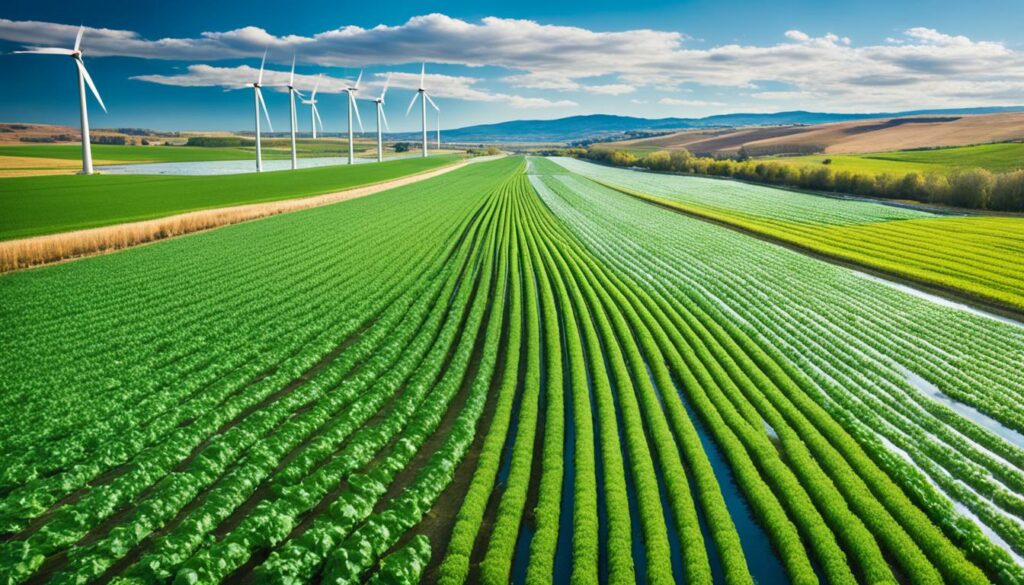
“Sustainable agriculture is not just about maximizing yields, but about preserving the delicate balance of our natural resources for future generations.” – Dr. Emily Harrington, Agronomist
The Benefits of Sustainable Agriculture Practices
Sustainable agriculture brings many benefits, affecting the environment, communities, and the ecosystem8. It helps with soil health, promotes biodiversity, and makes farming more eco-friendly and resilient.
One big plus is how it keeps soil healthy and fertile, which helps with water and prevents soil erosion8. It also supports many different plants and animals, making ecosystems thrive8.
It’s great for saving water too, using less through smart irrigation and choosing the right crops8. Plus, it helps fight climate change by storing carbon through things like trees and cover crops8.
Using fewer synthetic fertilizers cuts down on harmful gases, making farming less harmful to the planet8. It also means using safer, natural ways to grow food, which is better for people and the planet8.
This type of farming keeps important services like pollination and nutrient cycling going strong8. It makes the air cleaner and helps animals, making the environment better for everyone8.
It also helps rural communities by supporting fair work and local food systems8. As the world’s population grows, sustainable farming is key to feeding everyone without harming the planet9.
Enhancing Quality of Life for Rural Communities
Sustainable agriculture is more than just good for the environment. It helps make rural communities strong and resilient. By supporting fair work, helping small farmers, and boosting local food systems, it makes sure people who work the land are well taken care of10. This approach strengthens the social ties in rural areas, making them sustainable for the long run. It also makes life better for those who live and work there.
Sustainable agriculture does more than protect the environment11. It also helps rural communities deal with health and economic issues. Industrial farming can be harmful in these areas11. By choosing sustainable farming, we can make people healthier and help the economy and social life of these important communities.
The Ever-Growing Family Farm is a great example. It began in 2014 with a goal to get a family member to farm full-time10. Nfamara Badjie, a founder, used rice farming methods from West Africa in New York, showing sustainable farming can work in different places10. Thanks to community support and creative funding, like a GoFundMe campaign, the farm has become a model for improving rural economies and life quality.
“Sustainable agriculture investments can impact multiple generations, improving health and well-being across various stakeholder groups.”
Creating a sustainable future means seeing the big picture. Sustainable agriculture does more than protect nature. It empowers rural communities, leading to stronger local economies, better health, and a brighter future for everyone.
Meeting Growing Food and Fiber Demands
The world’s population is growing fast, making us need more food and fiber. By 2050, we’ll need 70% more food12. Sustainable farming is a key solution. It makes the most of land without harming the environment or wasting resources13.
Addressing Rising Global Population
Techniques like growing different crops, farming with precision, and using resources wisely can help. These methods boost food production without harming the earth12. They also make soil healthier, which means better crops and food quality13. Plus, they help make sure everyone has enough food by supporting local food systems13.
More farmers are turning to sustainable farming because it’s smart and works well12. By looking at the big picture and working together, we can feed everyone without harming the planet12.
| Benefits of Sustainable Agriculture | Environmental | Social | Economic |
|---|---|---|---|
| Improved Soil Health and Fertility | ✓ | ✓ | |
| Enhanced Biodiversity | ✓ | ||
| Reduced Pollution and Contamination | ✓ | ✓ | |
| Increased Food Security | ✓ | ✓ | |
| Economic Profitability | ✓ |
By choosing sustainable farming, we can meet our food needs without hurting the planet or our communities13. With new ideas and a focus on sustainability, we can look forward to a better future for all1213.
Data-Driven Sustainable Agriculture
The future of farming is changing thanks to data and new tech. By using big data and AI, farmers can make better choices and use resources wisely. This makes farming more efficient and green14.
These new methods help farmers deal with unpredictable weather and pests. They can choose practices that are good for the planet and profitable14.
Leveraging Big Data and AI
Data-driven farming gives farmers insights from past and current data on soil, weather, and crops15. It helps them save water by adjusting irrigation based on the weather. This also cuts down on crop diseases15.
Data analytics can also predict yields and crop quality. This helps farmers plan better, from planting to marketing15.
Precision farming is a key part of sustainable farming. It uses data to improve farming methods14. Farmers use data on weather, past yields, soil, and market trends to plan better15.
This approach combines data collection, analysis, and decision-making. It helps farmers use resources wisely and protect the environment16.
Data-driven farming has big benefits. It helps farmers make more accurate decisions than before14. It gives farmers the power to manage resources better, leading to more productivity and efficiency15.
As the world needs more food, data-driven farming is key16. By using data and AI, farmers can be more sustainable. This protects the environment, saves resources, and boosts profits15.
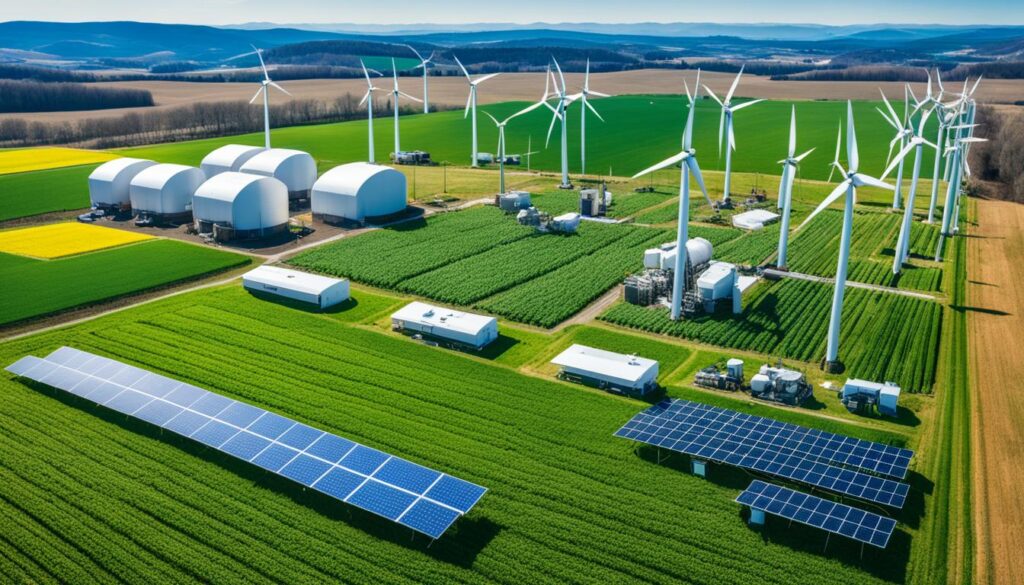
“Sustainable farming systems aim to ensure that capital in any form is not eroded while providing for production, consumption, and distribution objectives.”14
Using data and tech in farming is vital for tackling big challenges like resource scarcity and climate change. By adopting Data-Driven Farming, Sustainable Agriculture Technology, and AI and Big Data in Farming, farmers can improve efficiency, resilience, and care for the environment. This leads to a better future for farming.
Efficient Resource Utilization
Sustainable agriculture focuses on using natural resources wisely, especially water17. It uses methods like drip irrigation and selecting drought-resistant crops to save water17. This approach cuts down on water waste and makes sure we have enough water for farming and nature17.
By using water wisely, sustainable farming helps protect our water resources for the future17. This is crucial as the world faces a big challenge with water scarcity17.
Water Conservation Methods
Sustainable farming uses many ways to save water17. Precision irrigation sends water straight to the roots, cutting down on evaporation and runoff17. Harvesting rainwater and choosing crops that need less water are also key17.
These methods help farmers use water and energy better17. Drip irrigation and soil moisture sensors make sure water is used just right, saving it and boosting crops17. Cover crops and minimal tillage keep soil healthy and hold moisture, which means less need for irrigation17.
By adopting these efficient water practices, farmers protect our water for now and the future17. This helps farming communities and keeps our water-based ecosystems healthy17.
“Sustainable agriculture is not just about improving crop yields; it’s about safeguarding the precious water resources that sustain our planet and our future.” – Dr. Emily Walters, Sustainable Agriculture Researcher
Reducing Reliance on Non-Renewable Energy
Sustainable farming is moving towards renewable energy to power farms in a greener way. By using Sustainable Energy in Agriculture, farmers can cut down on non-renewable energy sources like fossil fuels. These fuels have harmed the environment and contributed to climate change18.
Solar power can lower farmers’ electricity costs, saving money over time18. In areas with steady wind, wind turbines can make extra money by selling excess electricity18. Also, farmers making their own biofuels from crops like corn or soybeans can use less non-renewable energy and keep fuel prices stable18.
Putting money into Renewable Energy Adoption cuts down on the cost of traditional energy, making farming cheaper18. Big farms can make a lot of clean energy with solar panels or wind turbines. They can power their farms and sell extra electricity18.
Programs like the Rural Energy for America Program (REAP) and the Investment Tax Credit (ITC) help farmers use Fossil Fuel Alternatives in Farming18. State programs like the Agriculture Energy Efficiency Rebate Program and the Small Business Advantage Grant (SBAG) also help farmers start energy-saving projects18.
By using less non-renewable energy, sustainable farmers help reduce greenhouse gas emissions. This move towards renewable energy is key for a sustainable and eco-friendly farming industry19.
The move to Sustainable Energy in Agriculture is good for the planet and meets what consumers want in farming. It makes farms more popular and respected in the industry19.
Mitigating Climate Change Impact
Sustainable agriculture is key in fighting climate change’s bad effects. By using agroforestry, cover cropping, and conservation tillage, farmers can store carbon in soil. This process, called carbon sequestration, helps reduce greenhouse gases and makes farms more resilient20.
In the U.S., farming adds up to 9.3% of the total greenhouse gas emissions, says the EPA20. To lessen this, farming methods like EOSDA Crop Monitoring are being used. These methods help reduce harm to the environment. Also, no-till farming and cover cropping are important for fighting climate change by storing carbon and preventing soil erosion20.
Carbon Sequestration
Carbon sequestration is crucial in sustainable farming. It captures carbon from the air and stores it in soil. This process improves soil health and fertility20. Techniques like agroforestry, cover cropping, and conservation tillage help reduce greenhouse gases. They slow down climate change20.
Farming can harm soil through erosion, reducing organic matter, and more. But, using cover crops and adaptive crops can fix these problems. These practices help with carbon sequestration, fighting climate change’s effects on farms20.
With more people on Earth, we need climate-smart farming more than ever. Sustainable farming and carbon sequestration let farmers fight climate change. They ensure food security and protect our planet21.
Promoting Organic and Regenerative Farming
Sustainable agriculture is changing how we farm, focusing on organic and regenerative methods. These methods use natural and organic products instead of synthetic chemicals. This leads to a healthier environment and food that is free from chemicals22.
Reduced Chemical Use
Organic and regenerative farming cut down on harmful chemicals. This helps protect the ecosystem and keeps farmers, workers, and communities healthy22. These methods improve soil health, making crops healthier and yields better22.
Soil becomes more moist, spongy, and full of life, which helps with water use and brings back biodiversity22. Regenerative farming also means less chemical use, which makes water cleaner and reduces harmful algae22. It can even take in 250 million metric tons of carbon dioxide each year in the US, helping fight climate change22.
Regenerative farming saves money by using fewer chemicals and growing more crops. It helps farmers pay off debt and reduces their risk. It also helps the economy in rural areas by improving processing and supply chains22.
It also helps communities by building stronger ties with customers and other farmers. It encourages working together for better market power22. Regenerative farming makes farmers happier and healthier, leading to a better work-life balance and freedom from the chemical industry22.
Organic and regenerative farming offer a complete solution to today’s farming challenges. They focus on natural and organic products. This protects the environment and improves the health of farmers, communities, and people around the world23.
Local and Regional Food Systems
Sustainable agriculture focuses on Localized Food Systems and Sustainable Food Supply Chains. It encourages food production, distribution, and consumption within local networks. This reduces the environmental impact of long-distance transport and helps Community-Oriented Agriculture24.
Local food systems improve transparency and traceability. They connect producers and consumers, making the food supply more sustainable and resilient. From 1994 to 2012, farmers markets grew from 1,700 to over 7,800. Now, more than 12,400 schools in all 50 states sell food from local farms, with over $13 million in sales24.
Support for sustainable agriculture has grown, with public markets, community-supported agriculture, and direct sales to institutions and retailers. Many cities, counties, and states have food policy councils to help local food and agriculture24.
Now, schools are not the only ones buying from local farms. Colleges, universities, hospitals, prisons, and corporate cafeterias also do. Restaurants and cafes are using high-quality, local ingredients too24.
Local food systems help farmers, protect the environment, and give people access to healthy food24. They make up a growing part of US agriculture, with small farms selling directly to consumers25.
More people want local food, creating jobs and opportunities in rural areas25. NIFA’s Gus Schumacher Nutrition Incentive Program had an $85 million economic impact in Year 3, up from Year 125.
| Key Metrics | Data |
|---|---|
| Increase in Farmers Markets (1994-2012) | From 1,700 to more than 7,80024 |
| Schools Involved in Farm-to-School Programs | More than 12,400 in all 50 states24 |
| Estimated Sales to Regional Farmers | More than $13 million24 |
| Economic Impact of NIFA’s Gus Schumacher Nutrition Incentive Program (Year 3) | $85 million25 |
NIFA supports many efforts, like research on food waste and nutrition, and programs for small farms25. They also work on sustainable agriculture, climate change, and food safety25.
NIFA helps small and medium-sized farms become more efficient and sustainable25. The USDA Climate Hubs Partnership gives region-specific info and tech for better farming decisions25.
“Local food systems have become an economic development strategy that supports local farmers, protects landscapes, and provides consumers with access to healthy and nutritious food.”
In summary, Localized Food Systems, Sustainable Food Supply Chains, and Community-Oriented Agriculture are key in sustainable agriculture. They offer many benefits to producers and consumers. These systems create jobs, protect the environment, and give people access to healthy food.
Supporting Smallholder Farmers
Sustainable agriculture sees the big role smallholder farmers play in feeding us and keeping rural areas thriving26. By giving them support and chances, sustainable farming helps these farmers use eco-friendly ways to farm. This improves their lives and makes food systems stronger and more resilient27. It makes sure everyone in farming gets a fair share of the benefits.
There are about27 500 million people earning by farming small plots. They are key to giving us things like tea, palm oil, veggies, and cocoa27. But, many don’t have the training, money, or tools they need. They also might not have papers showing they own the land, which makes planning for the future hard27.
To help, sustainable farming gives small farmers the tools and support they need26. It encourages using Integrated Pest Management (IPM) to fight pests safely26. It also suggests rotational grazing systems to make food better and save money26.
It also promotes soil conservation methods like strip cropping to stop soil from washing away26. Water conservation practices like planting around water help keep it clean26. Using cover crops and diverse farming makes farming better and more stable for small farmers26.
By backing Sustainable Support for Small Farmers, Empowering Rural Communities, and Inclusive Agricultural Practices, we’re really helping small farmers and making our food systems better27.
Preserving Ecosystem Services
Sustainable agriculture is key to keeping ecosystem services like pollination and pest control going strong6. By using diverse landscapes and fewer harmful chemicals, it keeps these services vital for farming6. This way, farming and nature work together well for the long run6.
About 40% of the Earth’s land is farmland, offering many ecosystem services28. These services give us food, forage, fiber, bioenergy, and medicines28. Practices like cover cropping and rotational grazing boost soil health and help society too29.
Figuring out the value of ecosystem services is important28. It helps us understand their worth and manage them better28. As we learn to value these services more, we can meet both environmental and economic goals28.
Sustainable farming is good for the planet, the economy, and people6. It protects the environment, supports economic growth, and improves community life6. This approach meets the world’s growing need for food and fiber6.
The Earth’s ecosystems were valued at $16 trillion to $54 trillion per year, with an average of $33 trillion per year, larger than the global gross domestic product (GDP)29.
Practices like carbon sequestration help fight climate change by removing carbon dioxide from the air29. Sustainable farming makes agricultural systems more resilient, keeping ecosystem services available for everyone6.
Conclusion
Sustainable agriculture is more than just a way to farm. It’s a deep approach that connects human actions with the environment. It helps our soils, ecosystems, and planet overall30. With a growing population and climate change, sustainable farming is key30.
By making smart choices, we can create a better future for our planet31. Practices like crop rotation and cover cropping make soil healthier and cut down on harmful chemicals31. Sustainable farming also helps fight climate change by storing carbon in soil31.
New technologies like AI and drones will play a big part in making sustainable farming better30. With support from policies and groups, we’re moving towards a greener agriculture31. This change will keep our land and future bright and strong.
FAQ
What is sustainable agriculture and what are its key practices?
How does sustainable agriculture increase profitability for farmers?
What are the environmental benefits of sustainable agriculture practices?
How does sustainable agriculture enhance the quality of life for rural communities?
How can sustainable agriculture help meet the growing global demand for food and fiber?
How are data and technology shaping the future of sustainable agriculture?
What are the key water conservation methods used in sustainable agriculture?
How does sustainable agriculture contribute to the mitigation of climate change?
What are the benefits of organic and regenerative farming practices in sustainable agriculture?
How does sustainable agriculture support local and regional food systems?
What is the role of smallholder farmers in sustainable agriculture?
How does sustainable agriculture preserve essential ecosystem services?
Source Links
- The benefits of sustainable agriculture and how we get there – IBM Blog – https://www.ibm.com/blog/the-benefits-of-sustainable-agriculture-and-how-we-get-there/
- Sustainable Agriculture | Learn Science at Scitable – https://www.nature.com/scitable/knowledge/library/sustainable-agriculture-23562787/
- Journey 2050 Lesson 1: Sustainable Agriculture (Grades 9-12) – https://agclassroom.org/matrix/lesson/582/
- Sustainable Agriculture: Balancing Profitability With Social and Environmental Responsibility – https://www.transformationholdings.com/agriculture/sustainable-agriculture-balancing-profitability/
- Sustainable Farming Practices for Enhanced Profitability – https://www.farmraise.com/blog/sustainable-farming-practices-for-enhanced-profitability
- The Importance of Sustainable Agriculture – https://www.plugandplaytechcenter.com/resources/importance-sustainable-agriculture/
- What Is Sustainable Agriculture? – https://www.ucsusa.org/resources/what-sustainable-agriculture
- Top 10 Benefits of Sustainable Agriculture for the Environment – https://medium.com/@generalarticle/top-10-benefits-of-sustainable-agriculture-for-the-environment-7ef674452adb
- Sustainable agriculture: definition, advantages and policies – https://www.aninver.com/blog/sustainable-agriculture-definition-advantages-and-policies
- Resilient Farmers, Ranchers and Communities – https://www.sare.org/resources/social-sustainability-in-agriculture/
- Improving Human Health through Agriculture – https://navigatingimpact.thegiin.org/strategy/sa/improving-human-health-through-agriculture/
- What is Sustainable Agriculture? – https://sarep.ucdavis.edu/sustainable-ag
- Sustainable Agriculture – Importance & Components – https://www.nicheagriculture.com/sustainable-agriculture/
- Data-driven agriculture and sustainable farming: friends or foes? – Precision Agriculture – https://link.springer.com/article/10.1007/s11119-023-10061-5
- Data-driven agriculture: The key to sustainability – https://medium.com/@jenniferedeh877/data-driven-agriculture-the-key-to-sustainability-efcbc82c4266
- Unlocking the Power of Data-Driven Technology in Agriculture – https://www.dllgroup.com/en/blogs/blogsoverview/Unlocking-the-Power-of-Data-Driven-Technology-in-Agriculture
- Sustainable Agriculture: Benefits & Management Tips – https://eos.com/blog/sustainable-agriculture/
- Harnessing Renewable Energy: A Sustainable Future for Farming – https://extension.psu.edu/harnessing-renewable-energy-a-sustainable-future-for-farming
- Enhancing Sustainability on Farms Through Solar (2024)| 8MSolar – https://8msolar.com/enhancing-sustainability-on-farms-through-solar/
- Climate Change And Agriculture: Strategies To Mitigate Risks – https://eos.com/blog/climate-change-and-agriculture/
- Impact of Climate Change on Agriculture and Its Mitigation Strategies: A Review – https://www.mdpi.com/2071-1050/13/3/1318
- Regenerative Agriculture Part 4: The Benefits – https://www.nrdc.org/bio/arohi-sharma/regenerative-agriculture-part-4-benefits
- Embracing the Green Revolution: Sustainable Agriculture for a Healthie – https://mavunoharvest.com/blogs/news/embracing-the-green-revolution-sustainable-agriculture-for-a-healthier-planet
- Local and Regional Food Systems – https://humanecology.ucdavis.edu/sites/g/files/dgvnsk161/files/inline-files/Local and Regional Food Systems.pdf
- Local and Regional Food Systems – https://www.nifa.usda.gov/topics/local-regional-food-systems
- Sustainable Agriculture Programs – https://www.nifa.usda.gov/grants/programs/sustainable-agriculture-programs
- Empowering smallholder farmers | Unilever – https://www.unilever.com/sustainability/livelihoods/empowering-smallholder-farmers/
- Ecosystem services and agriculture: tradeoffs and synergies – https://www.ncbi.nlm.nih.gov/pmc/articles/PMC2935121/
- Payments for Ecosystem Services – ATTRA – Sustainable Agriculture – https://attra.ncat.org/publication/payments-for-ecosystem-services/
- Importance and Future of Sustainable Agriculture – https://online.maryville.edu/blog/importance-and-future-of-sustainable-agriculture/
- Advantages and Disadvantages of Sustainable Agriculture – https://agriplanting.com/advantages-and-disadvantages-of-sustainable-agriculture/

